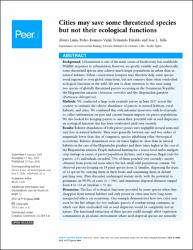| License | Creative Commons CC-BY 4.0 | es |
| Author | Luna, Álvaro | |
| Author | Romero-Vidal, Pedro | |
| Author | Hiraldo, Fernando | |
| Author | Tella, José L. | |
| Accessioned date | 2023-02-12T01:34:01Z | |
| Available date | 2023-02-12T01:34:01Z | |
| Year | 2018 | |
| Citation | Luna, Á., Romero-Vidal, P., Hiraldo, F. y Tella J. L. (2018). Cities may save some threatened species but not their ecological functions. PeerJ 6:e4908. REcuperado de: | es |
| URI | https://bvearmb.do/handle/123456789/2286 | |
| Abstract | Urbanization is one of the main causes of biodiversity loss worldwide. Wildlife responses to urbanization, however, are greatly variable and, paradoxically, some threatened species may achieve much larger populations in urban than in natural habitats. Urban conservation hotspots may therefore help some species avoid regional or even global extinctions, but not conserve their often overlooked ecological functions in the wild. We aim to draw attention to this issue using two species of globally threatened parrots occurring in the Dominican Republic: the Hispaniolan amazon (Amazona ventralis) and the Hispaniolan parakeet (Psittacara chloropterus). | es |
| Language | English | es |
| Published | PeerJ 6:e4908 | es |
| Rights | © 2018 Luna et al. | es |
| Rights URI | https://www.creativecommons.org/licenses/by/4.0/ | es |
| Subject | Biodiversidad - República Dominicana | es |
| Subject | Hábitats y especies | es |
| Subject | Especies amenazadas | es |
| Subject | Aves ─ República Dominicana | es |
| Subject | Ciudades sostenibles | es |
| Title | Cities may save some threatened species but not their ecological functions | es |
| dc.identifier.doi | https://doi.org/10.7717/peerj.4908 | |
| Material type | Article | es |
| Type of content | Scientific research | es |
| Access | Open | es |
| Audience | Technicians, professionals and scientists | es |


